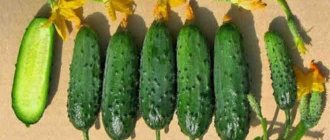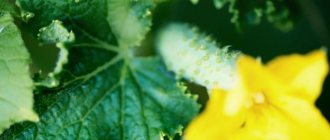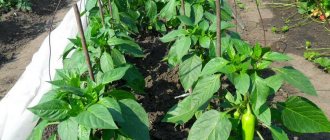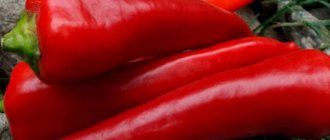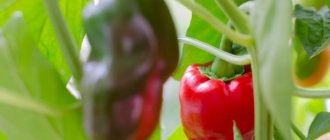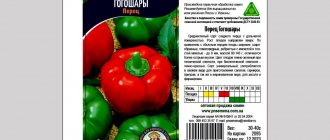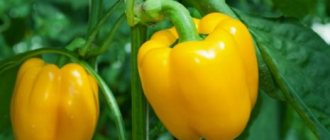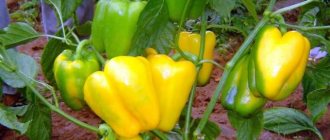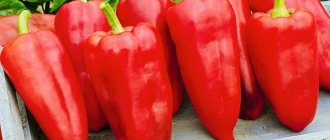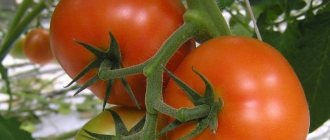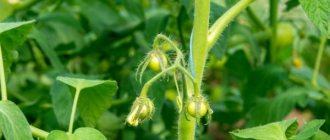Dutch pepper Gypsy has a very early ripening period and is not demanding in care. It has strong immunity and is suitable for growing in temperate climates.
Gypsy Pepper Seeds
weight of one fruit is approximately 110 g
The variety is characterized by uniform fruit size
Characteristics and description
The pods of the hybrid can already be added to fresh dishes two months after planting the seedlings in the soil. To get an early harvest, seeds for the greenhouse are sown already in February, and picking is not carried out due to the weak root system.
Appearance of the bush and fruits
The plant is not tall, reaches approximately 0.6 m, and is not too branched. The stems are thin and can break due to the slightest mechanical damage. The roots do not go deep into the soil; they are practically on the surface (about 0.25 m). The leaves are small, wide, bright green.
The bush begins to bloom 2.2 months after sowing; the flowers are small and white; there are both female and male flowers. Flowering continues almost until frost. The bush is self-pollinating, but cross-pollination is also possible.
Very often, Gypsy pepper is cross-pollinated with bitter crops, and its taste becomes overly pungent, so to avoid this, plants are planted farther apart (at least at a distance of 0.15 m). The pods are not very large, but have a beautiful shape. This hybrid is distinguished by the uniform size of the entire crop, the weight of one is approximately 110 g.
The main signs of the fetus:
- the skin is not thick, but quite dense, which is good for transporting the crop;
- the pepper is cone-shaped, slightly tapering towards the tip;
- walls approximately 5 cm thick;
- pulp with a characteristic crunch;
- has 3 cameras;
- yellow seeds.
A Gypsy pepper is technically mature when the fruit turns creamy yellow, fully ripened and red. The seeds of the hybrid have a high germination rate - about 80%.
Taste qualities
Farmers are satisfied with the taste characteristics of these vegetables. The fruits are juicy, but not too watery, the skin is crispy, and slightly sweet in taste. The fruit has no bitterness or pungency, everything is pretty standard. The aroma of vegetables is especially attractive; it is pronounced, full, and characteristically peppery.
Productivity
The hybrid yields little, and this is not surprising. The reason lies in the fact that almost all early crops are not highly productive. Their main feature is that while other vegetables are just beginning to bloom and form ovaries, these plants are already delighting with their fruits.
You can collect Gypsy pepper from 1 sq. m approximately 4-4.5 kg of crop, respectively, about 12 pods are formed on one plant.
What kind of pepper is this
Let's take a closer look at what Gypsy pepper is, its main characteristics and distinctive features.
Hybrid F1
The Gypsy F1 hybrid was launched in 2005 by the Dutch company Monsanto Holland. Pepper seeds are supplied to the Russian market by Semenis. In 2007, the hybrid was included in the State Register of Breeding Achievements used for cultivation in the Russian Federation.
This pepper is most often planted in gardens and gardens. Subject to compliance with agricultural technology and care rules, it is recommended for cultivation in the Urals and Siberia (under film cover).
Characteristics and description of the hybrid
Gypsy belongs to the early maturing Dutch hybrids . The first fruits appear 60 days after the seedlings are planted in the beds. The hybrid is intended for cultivation in a greenhouse and in open ground.
Gypsy pepper has a universal table purpose . It is eaten fresh, used in the preparation of various dishes and canned.
Distinctive features
The bushes of the plants grow of medium size , the branches are semi-spreading, the stems are not strong.
Attention! To prevent the pepper from falling from gusts of wind and under the weight of the fruit, immediately after planting it is called to a support peg.
The foliage of pepper is bright green.
Fruit characteristics, yield
The fruits of the Gypsy hybrid are not large, but their shape is even . The average weight of one pepper is 110 g. Length - 10-11 cm, width - 5-6 cm.
Features of the fruit:
- the skin is thin but dense;
- the shape is cone-shaped, gradually tapering upward;
- walls 5-6 mm thick;
- the pulp is juicy, crispy;
- the taste is sweet, without bitterness or pungency;
- Resistant to cracking.
Important! Peppers are technically ripe when they turn yellow. Only fully ripened fruit has a bright red color.
The Gypsy hybrid is consistently productive . During the season, from one plant you can harvest from two to 2.5 kg of pepper.
Pepper Gipsy F1 (Seminis) crop in the field
Growing conditions
The Gypsy hybrid does not have any special care requirements, however, to speed up the process and obtain the best results, some nuances will have to be observed.
It likes to sprout in warm soil, so plant it in beds in the shape of 0.5 m mounds. Another nuance is that the bushes do not have dense foliage, so in order to avoid the pods burning out in the sun, it is better to shade the sprouts a little.
Deadlines
The timing of growing Gypsy depends on where you are going to grow the bushes and when you plan to transplant them into open ground. If you are the owner of an excellent greenhouse, and you know that the plants in it are not afraid of frost, then you can plant seeds for seedlings already in the first days of March, respectively, plant them in the greenhouse in the last week of April.
In this case, you will begin to harvest the crop from the beginning of summer; in good conditions, the plant will bear fruit for a long time, and it will bear fruit for about 2 months.
If you do not have a greenhouse or you decide to plant seedlings directly in open ground, then you should wait a little and sow the grains in early April.
Selection of capacity
Almost all summer residents claim that the Gypsy pepper does not tolerate replanting, much less picking. The roots of the plant are sensitive and it is easy to damage them; to avoid this, plant the grains directly in individual pots. An excellent option is peat cups, especially since the seeding material for Gypsy peppers is not the cheapest and you don’t want to damage the plants.
Substrate requirements
Gypsy pepper is not particularly picky about soil, but it likes to grow in loamy or sandy loam soil with humus. The culture does not tolerate large amounts of nitrogen in the soil. Slightly acidic soil is not suitable for growing early varieties, so add chalk or lime to the soil to increase acidity.
You can choose a substrate for peppers or use a mixture for growing indoor plants. They are similar in composition, and this culture can grow and develop in them.
Growing and care
5–6 bushes are planted per square meter. The soil temperature needs to be at least 15 degrees, the air temperature at least 12 degrees. Before transplanting, the seedlings are taken out into the open air for a week: first for an hour, and then for the whole day.
By the time of transplantation, the seedlings should have several buds or open flowers using agricultural technology. The phase begins at about 2 months of age. If the seedlings have outgrown, it is better to pick off the first flowers, otherwise the bushes will take a long time to take root.
The soil is dug up in the fall, adding manure (5 kg per 1 sq. m). Before planting, add a teaspoon of superphosphate to the hole and mix with soil.
The peppers are carefully removed from the pots and lowered into the hole, making sure that the bush remains buried at the same height as when growing at home. Plants are watered
Weeding and loosening
While weeding, you need to destroy all the weeds in the garden bed. You should also weed the row spacing so that the pepper gets maximum sun.
Loosening the soil increases productivity. Crusty soil is poor in oxygen, roots hardly develop there, and plants turn out frail. Loose, weeded, well-fertilized soil with optimal moisture is a reliable basis for excellent harvests.
Watering and fertilizing
Water the planted seedlings as quickly as possible. The second watering is carried out 2-4 days later, depending on the weather. Pepper should not dry out until it loses turgor: it is a moisture-loving crop that responds to drought by dropping flowers and ovaries.
Watering cannot be done by sprinkling. Water should be run along the furrows or poured from a watering can at the root. Optimally organize drip irrigation. Water falling on the leaves spreads spores of fungal diseases and leads to an outbreak of late blight.
Do not water with cold water from a well. The temperature of the liquid should not be lower than 20 degrees.
The best time to water is morning or evening. Water poured onto a garden bed in the hot sun is a stress factor for plants.
The high yield of Gypsy pepper requires several feedings. The hybrid removes a lot of nutrients from the soil: the soil needs to be fertilized with humus or manure.
If you fill the soil with superphosphate and organic matter even during planting of seedlings, in the future you can limit yourself to two feedings:
- 20 days after planting (with complex mineral fertilizer according to the instructions for the composition).
- 2 weeks after the first (phosphorus-potassium fertilizer or ash tincture).
Garter
The compact low bush Gypsy does not need trellises. If you do not pick the fruits green, the plants will die under their weight. It is necessary to tie the bushes to low pegs with synthetic twine.
Gypsy bears fruit within 2 months. In order to produce more fruits, you need to cut off those that have already reached technical ripeness. If you wait until the peppers turn red, fewer will set.
Planting a hybrid
You can grow peppers directly in open ground, but it is better to use seedlings. Moreover, not every region can afford to plant seeds directly into the ground.
Preparing and sowing seeds
First of all, select the best ones from all the seeds; they should be strong and without damage. Then soak them in a weak solution of potassium permanganate, high-quality seed will remain at the bottom, and bad seed will float to the surface. Rinse the remaining grains well under cold water and dry.
Sow the seeds in the soil mixture, cover with film, place the containers in a warm place, the temperature should be about +25 degrees Celsius. The grains will germinate after 1-1.5 weeks.
Picking seedlings
As mentioned earlier, the stems and entire root system of the Gypsy pepper are weak, so when picking, use maximum caution and accuracy. It is very difficult to damage the sprouts; once the roots are disrupted, the plants cannot recover.
Experienced farmers recommend completely abandoning picking and all kinds of transplants. Sow each seed in a separate pot.
Seedling care
As soon as cotyledon leaves have formed on the sprouts, lower the temperature to +16 degrees, and at night drop it to +12 degrees. Monitor the soil moisture and do not allow it to dry out. Pay special attention to feeding seedlings. Make the first application of fertilizers a week after picking the sprouts (if it was done). Use simple mineral ingredients.
Make the second application of fertilizers 10 days after the first. You can use the same thing as the first time. You can use this remedy: 2-3 tbsp. l. ash + 1 liter of water, leave the mixture for 5 days. Before watering the plants, dilute it in a 1:1 ratio.
The third application of fertilizer is carried out 4 days before the direct transplantation of sprouts into open ground with ready-made fertilizers diluted according to the instructions.
Apply all fertilizers during watering: first add water, then the product, then water again. This algorithm will prevent the sprouts from getting burned, especially if you made a mistake with the dosage.
Hardening
When growing pepper seedlings, hardening is a mandatory process. During the day, take the sprouts out into the fresh air; before transplanting, the plant should reach 0.2 m in height and have approximately 10 leaves.
Characteristics of the variety
This pepper variety was bred by a Dutch company, its seeds come to Russia through the Seminis company. The State Register of the Russian Federation approved the pepper variety in 2007 and allowed the planting of seeds throughout Russia. Personal subsidiary plots are excellent for growing fruits in open ground or in greenhouses.
Advantages and disadvantages
This type of sweet pepper has many advantages that will be an advantage when choosing a pepper variety, including:
- early maturation;
- unpretentiousness and quick development in any weather conditions;
- does not require special soil and care;
- pepper bushes do not take up much space;
- resistant to the tobacco mosaic virus common among peppers;
- excellent taste and shape of the fruit;
- high productivity;
- universal use of fruits.
Disadvantages of a hybrid:
- thinness and fragility of stems;
- the need to tie up the bushes due to the heaviness of the fruits.
Description of the bush
The Gypsy F1 pepper bush is medium branched, grows up to 50-60 cm in height, and is considered low. The stems are brittle and can be damaged due to the weight of the fruit. The root system goes into the ground no more than 25-30 cm. The leaves of the bush are medium-sized, non-wrinkled, green in color.
The bush blooms 60-70 days after sowing the seeds. The male and female flowers are white and small in size. Flowering continues until cold weather and differs in its duration.
Transplantation into open ground
It doesn’t really matter where the peppers will be grown - in open soil or in a greenhouse; during transplantation, they must be tied to pegs or a special trellis.
Landing dates
Transplanting seedlings into open soil is carried out at a time when the threat of winter frosts completely disappears. Consider the fact that by this time the soil should warm up by +15...+18 degrees Celsius.
A sprout may have several flower buds at the time of transplantation. The age of the seedlings is 2 months. If the sprouts have already reached 70 days, then all the flowers and buds are torn off from them, otherwise they will take a long time to take root, and fruiting will take much longer than expected. Seedlings with dense buds take root faster.
Selecting a location and planting depth
Prepare the area for planting peppers in advance. Dig up the soil using a shovel, collect all the weeds and apply fertilizer. To prevent seedlings from getting sunburn, plant them in the afternoon or in cloudy weather.
Dig holes the size of the pot the plant is currently in. Fill the hole with humus, make the distance between the holes approximately 0.4 m. To make it easier to water and care for the pepper, you can plant it not in even rows, but in a checkerboard pattern.
Video review of the Gypsy hybrid, its yield and ripening time in open ground:
Growing seedlings
Growing pepper seedlings is not difficult if you know how to do it correctly.
Planting pepper
In the picking option, the seeds are planted in a common container in pre-moistened soil to a depth of 1 cm . If without picking, then you need to plant them immediately in separate containers.
To ensure reliable germination, you can take 2-3 seeds per dish and then leave the strongest plant. Then the container is covered with film and placed in a warm place - for example, near a radiator. Mostly, the seeds germinate within a week, sometimes a little more.
Afterwards, the film is removed and the seedlings are kept at a temperature of +16-18 °C during the day and +14 °C at night for a week. This is necessary to prevent the peppers from stretching and forming a powerful root system. During the rest of the period, the temperature is maintained within +18-25 °C.
Further care
Water the seedlings regularly as the top layer of soil dries. Picking is carried out only when the top two leaves grow.
During the period of plant growth, several feedings are done with mineral fertilizers. The first time - 7 days after picking, or 14 days after germination, if planted without picking. The second time is fed 11-12 days after the first time. The third time, fertilizers are applied a couple of days before transplanting the seedlings into open ground or a greenhouse.
Transplant the seedlings to a permanent place carefully so as not to break the fragile stems of the plant. Before planting, fertilizers are placed in the hole; humus is best. Peppers are planted in a row at a distance of about 30 cm from each other, and up to 50 cm are left between rows.
Important! During the flowering period, when the fruit begins to form, it is recommended to increase the frequency of watering.
Features of caring for Gypsy pepper
Sweet pepper Gypsy does not need special care, but some actions must be performed, only then you can get an early harvest.
Weeding and loosening
Weeding consists of destroying all the weeds growing around and near the plants. Be sure to get rid of it, since the grass contains fungal spores and various bacteria that can attack the peppers at any time.
Loosening the soil has a beneficial effect on the growth of this crop. This event will saturate the soil with air and increase the supply of useful elements. Loosening is carried out after watering or rain.
The depth of loosening directly depends on the development of the pepper: before flowering - 6 cm, during flowering - 10 cm, at the beginning of fruiting - 14 cm, gradually decreasing to 6 cm.
Watering and fertilizing
The first time plants in open soil are watered is at the time of transplantation. Water is added to the holes and seedlings are planted. After 4 days, water again.
Before the fruiting period, peppers are moistened once a week. As soon as the first fruits appear, stop adding water. Renew before the second flowering begins.
Rules for watering peppers:
- Use only warm and settled water (+22 degrees and above).
- Water the plants in the morning or evening.
- Do not pour directly under the root, do not wash away the soil.
- 1 plant needs 2-2.5 liters of water.
Gypsy pepper produces a good harvest when it is fully supplied with useful components. During the growing season, fertilizing is applied 3 times.
- 20 days after direct planting of plants in open soil (mineral fertilizers).
- At the beginning of fruiting (organic).
- 14 days after applying the second fertilizing.
The best dressings for peppers:
- Herbal infusion. Take 2 kg of various herbs, fill them with 10 liters of water and leave for 6 days to ferment. Mix the resulting mixture with water (1:10) and pour it over the plants.
- Chicken droppings. 250 g of organic matter and 10 liters of water. Leave the mixture for about 4 days, stirring occasionally. Dilute 0.5 liters of the product in 5 liters of water, water the plant at a distance of 0.3 m from the trunk, do not get it directly on the foliage.
- Mineral supplements. Take superphosphate and urea (10 g each) and dissolve in 10 liters of water. 1 plant needs 0.5 liters of product.
Garter
Gypsy needs a garter. The branches of the plant are very weak, so they are severely damaged by fruits and wind. In order for the plant to rest on something, dig a support in the form of stakes 0.7 m high near each bush during replanting. There is no need to tightly tighten the bush and the support with fabric strips, the plant should feel free.
In the greenhouse, the peppers are tied with twine, the second end of which is secured to the upper horizontal support.
Care
Sweet pepper Gipsy f1, according to the description, is undemanding in care, but proper agricultural technology will allow you to get well-developed bushes, high yields and even, regularly shaped fruits. Peppers need regular moderate watering, loosening the soil, weeding, fertilizing and staking.
Watering and loosening
The first watering is carried out at the time of planting seedlings. The planting holes are shed with water, and when the moisture has been absorbed, young plants are planted. After 3-5 days, watering is repeated.
Throughout the season, the bushes are watered once a week until mass fruiting occurs. When the first batch of fruits has started, watering is stopped. Resume after harvesting at the beginning of re-flowering.
Among the basic rules of high-quality watering, the following should be highlighted:
Water for irrigation should be settled and warm (above 22°C). Watering is carried out in the morning or evening. Water the bushes at the roots carefully so as not to erode the soil. To water one bush, 2-2.5 liters of water is enough.
Loosening is carried out after watering. And also after the rain. The depth of loosening depends on the stage of plant development. Before flowering, loosening of row spacing is carried out to a depth of 5-7 cm. When the bushes begin to bloom, increase the loosening depth to 10 cm, and by the period of fruiting to 14 cm, and gradually reduce to 5-7 cm.
Top dressing
Pepper requires mandatory feeding
Gypsy f1 pepper grows well when it is provided with sufficient nutrients. Fertilizing is carried out three times during the growing season. This will be enough to provide the plants with the required amount of microelements.
Feeding is carried out:
- 20-25 days after planting the seedlings.
- At the beginning of mass fruiting.
- Two weeks after the second.
It is better to apply fertilizers in liquid form during the growth period. Organic and mineral fertilizers are suitable for feeding peppers. During the fruiting period, it is better to use organic fertilizers, as it is environmentally friendly.
To fertilize plants, you can use herbal infusion, manure, bird droppings, and mineral fertilizers.
- Herbal infusion. To prepare, take 2-3 kg of various fresh herbs (nettle, dandelion, lawn grass, medicinal herbs), add 10 liters of water and leave for 5-7 days to ferment. The finished infusion is mixed with water in a ratio of 1:10 and the bushes are watered or sprayed.
- Bird droppings. Chicken or pigeon is good; 250 g of droppings are enough for 10 liters of water. The solution is infused for 3-5 days, stirred occasionally. Add 0.5 liters of prepared bait to a bucket of water. Water around the bush at a distance of 20-30 cm from the trunk, avoiding getting on the leaves.
- Mineral fertilizers. Superphosphate is used together with urea. Take 10 g of each fertilizer and dissolve it in 10 liters of water. Water the bushes in the afternoon. For one bush, ½ liter of solution is enough.
Tying up
This variety requires garter. According to the description, Gypsy f1 bushes have fragile stems that can be damaged by the weight of the fruit and the wind. To tie up the plants near each bush at the time of planting the seedlings, install a support. For this variety, it will be enough to drive stakes 60-70 cm high. The main stem is tied with fabric strips in several places at different heights. There is no need to strongly pull the stem to the support; the garter should hold the plant, but not limit free growth.
Prevention of diseases and pests
Gypsy pepper is resistant to tobacco mosaic, but it needs treatment for late blight, sclerotinia, bacterial spot and rot. Preventive measures not only strengthen pepper immunity, but also increase plant resistance. To treat various diseases, use peroxide, iodine and biofungicides.
Gypsy pepper is affected by the following pests: aphids, spider mites and whiteflies. To scare them away, you need to regularly spray the plants with herbal infusions. Use wormwood, onions and potato tops.
To get rid of pests for a long time, use special insecticides such as Actellik and Aktara.
Varieties for Siberia
The following varieties are suitable for more severe conditions:
Kolobok. The culture of Moldovan breeders is ideally adapted to the conditions of Siberia. An early variety of pepper bears fruit well in open ground. It is distinguished by a short bush that is easy to care for. The three- and four-chambered fruits have tender red flesh that is about 9mm thick. The maximum weight of one pepper is 90 g.
- Topolin. The plant may have two stems, resulting in a tall bush that requires staking to a trellis. The first crop can be removed 110 days after germination. Green peppers turn red when ripe. The fruits are not fleshy with thin walls, weighing no more than 150 g. If measured on a large scale, then from 1 hectare you can harvest about 50 tons of crop, which is 5 kg/m2.
- Novosibirsk. An early ripening variety of pepper is bred for cultivation in Siberia. After 2 months, seeds sown in February produce strong seedlings that can be transplanted into a greenhouse. After 95 days it produces the first peppers. As for the yield, from 1 m2 you can get about 4 kg. The bushes grow up to 1 m in height, producing peppers weighing up to 58 grams with aromatic red flesh 6 mm thick.
- An early miracle. The culture belongs to the early fruiting period. Ripe fruits can be obtained 90-105 days after germination. The variety is immune to viral diseases. The bush can grow up to 1.2 m, which requires garter. When ripe, the pepper turns red.
Montero. The bush up to 1.2 m high is suitable for growing in any type of greenhouse. The fruits are very large, the pulp thickness is 7 mm and weighs about 260 g. With good feeding, you can grow giant peppers weighing up to 940 g. The variety is considered high-yielding, since 7-6 kg of fruit can be harvested from 1 m2.
Advantages and disadvantages of sweet pepper Gypsy
The Gypsy pepper hybrid, like other peppers, has its pros and cons; they must be taken into account when growing the plant.
Advantages of the hybrid variety Gypsy:
- the possibility of transportation without loss of taste and appearance of the pods;
- excellent aroma and excellent taste of the fruit;
- a considerable amount of harvest;
- early ripening;
- does not require special care;
- relatively strong immunity;
- not afraid of sudden temperature changes and weather changes.
Disadvantages of Gypsy:
- the walls of the fetus are thin;
- harshness of fruits even after heat treatment;
- need support;
- cannot tolerate picking or transplanting.
Rules for planting and growing
If you decide to start growing this pepper, then when planting you should remember the following:
The soil should be prepared in advance so that the peppers take root well in it.
Important! It is best to dig it up with humus or peat a few weeks before planting. The place for planting the plant must be selected with sufficiently good lighting. Important! The bushes of this variety do not have such a large leafy part, so on too hot days it is worth shading the plants so that they do not get burned from the scorching rays of the Sun. Initially, it is worth building a support-type peg for each bush; this is necessary so that the bushes do not break when fruit appears.
In order to avoid various problems, when growing this variety you must follow these rules:
Provide plants with adequate watering
Important! The frequency of watering should be adjusted depending on the weather outside. When there is a lot of rain, plants do not need artificial watering. Apply fertilizing in a timely manner
It is best to do this in the spring and autumn. Proper application of fertilizing will ensure a large amount of harvest. From one bush you can collect up to 4.5 kg of fruit. If you notice dried or damaged parts of the bush, they should be removed immediately.
Reviews
★★★★★
Antonina, 42 years old, cook, Kirsanov. I like Gypsy peppers, especially for their early ripening.
It’s expensive to buy pepper at the market at this time, but our family is already feasting on its harvest. It's great. The bushes also do not grow very tall; our largest plant reached 0.6 m, so it can be grown not only in open ground, but also in a greenhouse. In all the years of cultivation, the bush has never been sick; even pests avoid it. The pods are all even, not particularly large, but tasty and aromatic. The only thing I don’t like is the need for garters, during which the branches break and bend. The Gypsy pepper is very frail in appearance, and that year, half of the seedlings died; the plants could not bear the picking. Now I plant only in separate containers. ★★★★★
Oleg, 49 years old, builder, Krasnouralsk. My wife and I have a dacha; I built it myself, but my wife takes care of the garden.
So, 2 years ago, she decided to grow peppers, and one that would yield a harvest at the beginning of summer. We decided to buy Gypsy seeds, and have never regretted it. Early ripeness is really its advantage. The pods are all even, beautiful, smooth. The taste is excellent. I really didn’t really like the general appearance of the plants, despite all the fertilizing applied, the bushes grew frail, there was little foliage, some were even curled. I wouldn’t recommend growing Gypsy peppers to decorate your garden, but to get a tasty and rich harvest, you won’t find a better variety. Hide
Add your review
The early hybrid of Gypsy pepper has proven itself to be excellent among gardeners; it does not require a lot of care and produces a fairly large amount of harvest. You can grow bushes not only for yourself, but also for sale. Suitable for preparing fresh salads and canning.
0
0
Copy link
Similar hybrids
According to the description and characteristics, Gypsy pepper is similar to the following hybrids:
- Pinocchio F1;
- Tempo F1;
- Adler F1;
- Fisht F1;
- Admiral F
Pinocchio is a tall hybrid that grows up to 1 meter when cultivated in greenhouses. In open ground, the bush rarely exceeds 0.7 m. Pepper reaches the stage of technical maturity 3 months after the seedlings emerge. Fruits of the Hungarian type (cone-shaped) weighing 120 g. and up to 17 cm long. The thickness of the pericarp is on average 5 mm. Taking into account the planting density of 5 to 8 plants per square meter, 11-14 kg of crop is harvested, respectively. When biological ripeness occurs, the fruits acquire a dark red color.
Temp F1 is an early ripening and drought-resistant pepper. The bushes are medium-sized, not exceeding 60-70 cm. The fruits are cone-shaped, red, weighing 100-120 g. Productivity per sq. m. ranges from 6 to 9 kg, depending on cultivation conditions.
Adler belongs to the mid-early hybrids with a ripening period of 98-112 days from the beginning of the growing season. The bush is tall, up to 1.3 m, standard, medium leafy. The hybrid is well adapted to adverse weather conditions. The color of the fruit when fully ripe is red. The average weight of one copy is 140 g. The plant has average resistance to diseases.
Fisht has early ripening periods. After planting the seedlings in the ground, the hybrid produces a harvest within 50 days. Cone-shaped ripe red peppers, weighing up to 180 g. The fruits are very thick-walled - up to 1 cm, some specimens have a pericarp up to 2 cm. The plant tolerates lack of moisture and heat well.
Admiral F1 produces a harvest 100 days after germination. The bush grows up to 1-1.3 m. Cone-shaped fruits with a wall thickness of 6 mm weigh from 140 to 150 g. When fully ripe, they acquire a red color. The hybrid is resistant to drought and disease, vegetables have good transportability. Yield indicators are 5.4-6.2 kg.
Description of fruits
The following characteristics can be observed in the fruits of gypsy pepper:
- The growth form of peppers is drooping, but the shape of the fruits themselves can be attributed to the Hungarian type, that is, it is classic, conical.
- The skin is quite thin, but at the same time dense and glossy.
- The thickness of the fruit walls is on average small, about 5-6 mm, although according to some reviews it can reach up to 8 mm.
- The fruits themselves are not particularly large in size; they reach 13-15 cm in length, and the widest part of the cone is 6 cm. The average weight of one peppercorn is 100-150 grams.
- The number of seed chambers is 2-3.
- Experts rate the taste of peppers as excellent. They are juicy, sweet, without the slightest hint of bitterness and very fragrant.
- The fruits at the initial stage of ripening are colored in a delicate light yellow shade, which resembles the color of ivory. The similarity is further enhanced by the waxy coating found on the outside of the fruit.
- During the process of ripening, the color of the peppers darkens and at the stage of biological maturity they become even red. Due to their early ripening, most fruits have time to fully color while still on the bushes and do not require ripening even in fairly northern regions of the country.
- The use of gypsy peppers is universal. Due to their small size, it is convenient to preserve them whole, as well as freeze them by nesting the cut fruits inside each other.
- They are very tasty fresh, and also as additives to various first and second courses. From dried fruits you can prepare paprika - a wonderful universal vitamin seasoning for the winter.
- Gypsy peppers store well because their fairly thick skin protects them from drying out.
- They are also able to withstand transportation over long distances.
Pepper fruits retain good presentation even after long-term transportation or storage. The fruit parts have the following characteristics:
- the average size of pepper is 11-14 cm in length and 5.5 - 6.5 cm in diameter;
- wall thickness does not exceed 5 mm;
- average weight is about 120-150 g;
- regular, conical shape;
- the pulp has a rich taste with moderate sweetness without bitterness;
- aroma – pronounced peppery;
- the skin is not subject to damage during transportation, glossy, dense;
- not prone to cracking when overripe;
- uniform bright red color of the surface when fully ripe.

